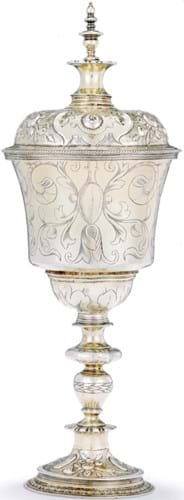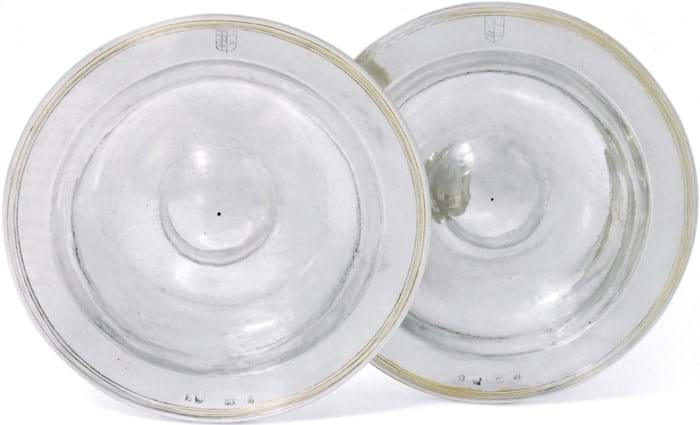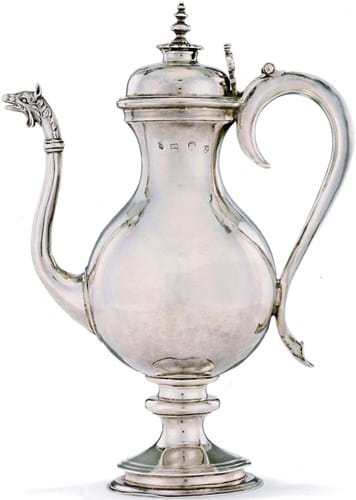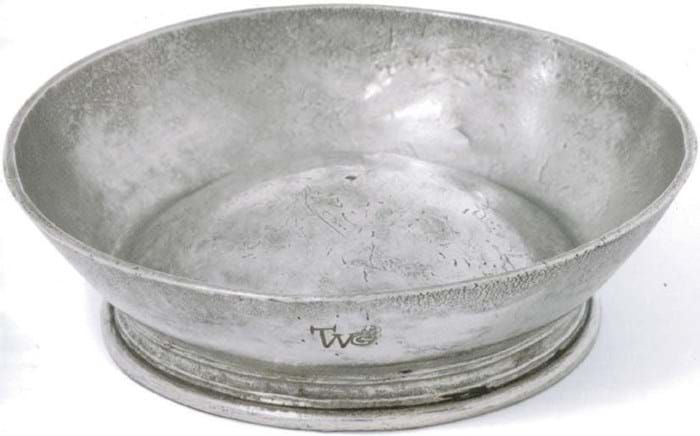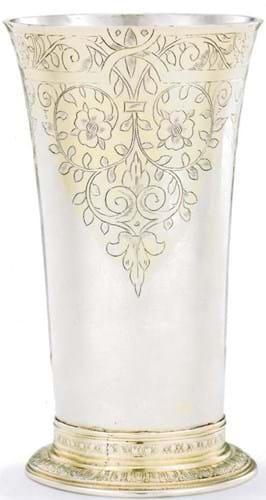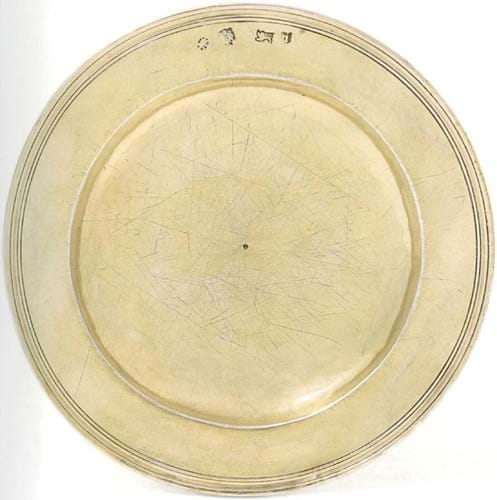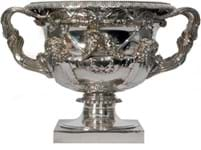David Little spent 28 years putting together his collection of early English silver. His interest in Elizabethan and Stuart social history was the spark for what proved to be a focus on a specific area of English goldsmiths’ work from the reigns of Elizabeth I through to Charles I, a field where the available material is in relatively short supply.
Little’s goal was to acquire an example of every type of form within this production period and to help achieve this he recruited Alastair Dickenson, the well-known and long-established silver specialist and dealer.
Dickenson helped him to build a small but choice collection of just under 30 pieces: beakers, covered cups, tazzas, tankards, dishes and spoons, as well as smaller personal pieces such as pomanders and counter boxes.
It is a reflection of the rarity of the field on which Little wanted to concentrate that Dickenson reckons the acquisition rate was around one piece per year.
Most of the items were acquired via Dickenson at auction and several had provenance to notable single-owner collections of older enthusiasts for early silver such as JP Morgan, Lord Harris of Peckham, Prof Richard Clive Cookson and the Albert Collection.
The entire ensemble was recorded for posterity by the silver scholar Timothy Schroder (who was also the curator for the celebrated early English silver and works of art collection of Arthur Gilbert).
Schroder’s work English Silver Before the Civil War: The David Little Collection was published in 2015. Little added just one piece to his holdings thereafter: a steeple cup.
Significant sale
Three years later came the announcement that Christie’s was to offer the Little collection as a single-owner auction in London at the end of last year (December 3).
An auction dispersal was not new territory for Little: his earlier enthusiasms for pewter and oak had also resulted in sales via Christie’s (25/20/13.5% buyer’s premium), the oak in 2001 and the pewter in 2007.
While it is a significant undertaking to amass this kind of collection in just over a quarter of a century, in market terms 28 years is not such a long time.
Indeed, over a third of Little’s pieces were probably acquired within the last dozen or so years.
As so often proves the case when works from traditional sectors return to market within a relatively short time to a purchasing pool that is unlikely to have changed much, values often do not rise, and they may even fall.
An extra factor stems from this being such a rarefied area. As Dickenson observed to ATG: “There is a limited number of collectors out there partly because so little of it comes on the market and when it does it is often in very poor condition because it is so old.”
As a result, the prices realised on December 3 were often at the lower end or below the pre-sale estimates and sometimes represented less than they had cost to acquire. However, as our selection shows, not everything gave a low-key performance.
Moreover, virtually everything found a buyer (five lots failed to change hands) for a final total that was just over £1.6m if one includes the buyer’s premium.
Christie’s confirmed that most of the buyers were established silver collectors, although the auction house noted that the sale benefited from being offered alongside the Old Master auctions with crossover interest from clients in that field. Christie’s catalogue had sought to show examples of each piece pictured in contemporary Dutch still-lifes and other Old Master pictures of the period.
A lot of plus points
“Practically everybody in the trade said to me the sale did well,” Dickenson said. His post-sale verdict was that there were a few very high prices in the collection and a few low prices. Overall he felt the ensemble “had a lot of plus points. Whether the timing affected it or not we will never know.”
It is also worth pointing out that the intrinsic interest and attraction of these pieces, virtually all of which are rare to market and often have detailed earlier provenance and interesting histories featuring notable personalities, remains the same. Unlike fluctuating values, those features will pass on to the new owners unchanged.
Pictured here is a selection of works from Little’s concentrated quarter-century of silver collecting.
The Pocklington Morgan cup (pictured top)
The highest-priced lot in the sale of David Little’s collection at Christie’s on December 3 was the so-called Pocklington Morgan cup, an 11½in (29.5cm) high, 15oz silver gilt covered cup made in London in 1589 by a goldsmith with the maker’s mark of two catkins.
Like most of the pieces in the collection, Christie’s catalogue named it after a previous owner (or in this case two of them): Col George Henry Pocklington (1833-1908), the first recorded, and John Pierpont Morgan (1837-1913), the famous American banker.
Little purchased it from Christie’s sale of the collection of Lord Harris of Peckham in 2002 when it cost a premium-inclusive £171,650 or £150,000 hammer, below its £150,000-250,000 estimate at the time. Offered this time around with a similar guide of £180,000-220,000, it realised £180,000 hammer or £225,000 including premium.
Armada Service dishes
Two Elizabeth I silver dishes from the so-called Armada service were one of the highlights of the Little Collection.
Plenty of romance and history come attached to the 31 silver dishes of various sizes hallmarked between 1581-1601 that make up this famous service, 26 pieces of which are now in the British Museum.
It was found in 1827 as a hoard buried in a potato barn in the village of Brixton, Devon. After an initial dispute over ownership between the occupier of the land and its proprietor, the identification of the arms on the dishes as those of Sir Christopher Harris (c.1553-1625) and his second wife Mary resulted in the service passing to his descendant John Harris.
Sir Christopher had close ties to Walter Raleigh and Francis Drake (to whom he was related through his second wife). This led to popular speculation that the service was struck from silver plundered from Spanish ships and had perhaps been a gift to Harris from Drake. It now seems more likely that Harris obtained the service by profit from his position as an admiralty official under Raleigh collecting booty.
After the service’s restoration to Harris, it remained with the family for nearly 60 years until 23 of the dishes went to auction at Debenham Storr & Son in 1885 and were bought by a distant family member. It appeared again at auction at Christie’s in 1911, by which time the extant pieces had grown to 26 dishes. These were finally acquired by the British Museum in 1992.
The two Little dishes measured 8¼in (21cm) in diameter weighed 9 and 10oz and were marked for London 1600 and 1601 with a maker’s mark probably for Thomas Ellis. Given that only five dishes remain outside the museum, the chance to acquire an example on the open market represented a rare purchasing opportunity.
“The Armada dishes are historically the most important pieces in the collection. If you go into practically any silver retail shop you will see a reproduction of one of those dishes,” said Dickenson.
Acquired for the Little Collection by Dickenson in 2009 at Lawrences of Crewkerne for a hammer price of £135,000 (approximately £161,000 inc premium), this time around they sold for £140,000 against a guide of £150,000-200,000.
Duke of Hamilton ewer
The final lot of the sale was known as The Duke of Hamilton ewer after a previous owner, the 11th Duke of Hamilton who had inherited a large collection of silver in part derived from the famous collector William Beckford.
The 31oz, 12¼in (31cm) high, slender-spouted ewer, marked for London 1625 and TH possibly for Thomas Holland, was the first piece of early silver Little acquired, purchased from the dealer Brand Inglis in the early 1990s. He owned a similar vessel in pewter.
It was a notable acquisition as a very rare piece (“as far as I know, the only one to be on the market since I was in the business,” observed Dickenson) and Christie’s chose it to illustrate the cover of the sale catalogue.
The ewer found a buyer at £120,000, under the lower end of the £150,000-200,000 guide.
James I basket
This James I basket was a piece that was making a relatively recent return to market having been acquired from a Christie’s auction in 2013 for £133,875 including premium.
The 27oz, 12¾in (32.5cm) diameter pierced and engraved basket, with a maker’s mark of three mullets, was unrecorded before that appearance at the rostrum. With hallmarks for London 1602, it is thought to be the third earliest known example of its type. At Christie’s last December it sold for a mid-estimate hammer price of £140,000.
Gilbert Vintry Wharf wine taster
From an historic angle this small and somewhat worn silver wine taster punched well above its weight.
The 3½in (9cm) 2oz vessel is dated to c.1570-80. That makes it the earliest surviving English taster of the Bordeaux type by some years, predating the example of 1603 from Lacock Parish Church that sold at Bonhams in 2002 for £56,000.
Its maker’s mark of LG is attributed to Lawrence Gilbert (or Gilberd) of Colchester, which also makes it a rare example of the Ipswich and Colchester smith’s work. Gilbert is thought to have been working in Colchester in the 1560s making communion plate for local churches.
The taster is traditionally thought to have been found on the banks of the Thames near the Vintry or Three Cranes Wharf not far from the Vintners’ Hall. This would account for its roughened surface. (Another taster marked for 1634, now in the Museum of London, was found in the same location in 1978.) The Little taster was previously in the Albert Collection and sold at the lower end of its £15,000-30,000 estimate.
“Whoever bought this wine taster got a real bargain,” said Dickenson. It certainly seemed a reasonable purchase when compared to the very high price paid for the admittedly more elaborately decorated Lacock church taster mentioned above.
Cosier beaker
Dickenson’s favourite piece in the Little Collection was the so-called Cosier beaker named after the first recorded owner William Cosier (1802-73).
The 8oz 6in (15cm) high tapering parcel-gilt beaker with delicately engraved foliate scrolling around the top half was a “stunning piece of silver”, its condition “like the day it was made”. Dated London 1618, with a maker’s mark of HB, it was another piece with provenance to a well-regarded collection, that of Prof Richard Clive Cookson. The little beaker sold at the upper end of its estimate for £60,000.
Elizabethan silver-gilt dish
A piece that improved considerably on the price it realised when last under the hammer was this little 4oz 6in (15cm) silver-gilt dish, marked for London 1570, which may have served as a spice dish.
Dickenson bought it at Woolley & Wallis in 2010 for £4800 against a more modest £1000-1500 estimate. Offered at Christie’s this time with a more substantial £5000-8000 guide, it nonetheless surpassed that level to take £9500.
Simpson St Matthias apostle spoon
Silver spoons are the most commonly seen survivors from the Tudor and Jacobean periods and have proved to be a popular collecting field in their own right. Little had two examples in his collection. One, an unmarked diamond-point spoon of mid- to late-15th century date failed to sell.
The other with an apostle terminal, shown above, was hallmarked for London 1515 and has a fringed S mark which has been attributed to the specialist spoon maker William Simpson. Three examples from a 1515 set of apostle spoons by Simpson have survived: one with a St Matthew terminal, another with a terminal modelled as St James the Less and this example whose finial represents St Matthias.
The spoon was formerly part of the Quernmore Collection, sold by David Lay of Penzance at auction in 1995. It next appeared at auction at Bonhams in 2008 when it realised £28,000 or £33,600 including premium. This time in the Little auction it made £30,000 hammer.


